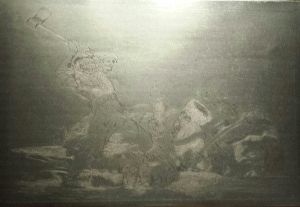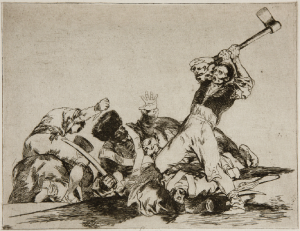Goya Engraving: The Disasters of War Series, Lo mismo
The series of engravings in the category of ‘Los desastres de la guerra’ entitled above were created between 1810 and 1820 by Francisco de Goya. This series contains eighty four very violent and graphic engravings presumably as Goya’s protest for of the war of independence that lasted 1808 to 1814. This was the period of time when Spain was under the control of the Napoleonic French troops after King Charles III signed Spain away and exiled to France with his family during the invasion. Napoleon’s brother, Jose Primero ‘Pepe’ became the king of Spain during this the period and even though he had a lot of ideas of liberation he was hated by the people because he came as a remembrance of the invasion.
The third engraving in this series interests me in particular because with as much as it is violent, it contains an objective message. It shows a man, one of the madrilenos about to cut off the head of a French soldier with an axe. The message is that both parts were as cruel as the other. There is no mercy in the man’s face, no humanity left in his eyes as the soldier holds his hands up in surrender. That during this time of disregard for human life, neither party has more of a right to take the other’s life.


On the foreground of the engraving we are introduced to death of a dead soldier lying on the ground, then the middle ground is the man about to slaughter the soldier and in the back still there is violence involving a man about to stab another soldier. The art of etching has been exquisitely done, very fine and detailed enough to tell the psychology on the faces of the people involved. Although the art piece relates a very strong subject matter in a visually hard to stomach way, the precision and genius of the artist Goya is remarkable.
Leave a Reply